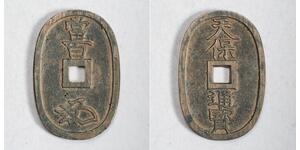(sold for $415.0)
1625, Saxony-Altenburg, John Philipp I. Large Silver 4-Brothers Thaler Coin. R!
Mint Year: 1625 Mint Place: Saalfeld Denomination: Thaler State: Sachse-Altenburg (Saxony-Altenburg) References: Davenport 7371, Schnee 278, Scarce! Condition: Minor dark oxidation deposits, graffiti (letters?) in reverse fields, otherwise about XF! Weight: 28.81gm Diameter: 45mm Material: Silver
Obverse: Armored and draped half-length figure of Duke Johann Philipp right. Date (16-25) split in fields above. Legend: + D:G : IOH : PHIL (shield) FRID IOH (double shield) WILH : ET . FR (shield) WIL : FRAT :
Reverse: Three armored and draped half-length figures of the Duke´s brothers right. Legend: DVC : SAXON (shield) IVL . CLIV (double shield) ET . MONT (shield) LIN : ALDEN
The Duchy of Saxe-Altenburg (German: Sachsen-Altenburg) was one of the Saxon duchies held by the Ernestine branch of the House of Wettin in present-day Thuringia. It was one of the smallest of the German states with an area of 1323 square kilometers and a population of 207,000 (1905) of whom about one fifth resided in the capital, Altenburg. The territory of the duchy consisted of two non-contiguous territories separated by land belonging to the Principality of Reuss. Its economy was based on agriculture, forestry, and small industry. The state had a constitutional monarchical form of government with a parliament composed of thirty members chosen by male taxpayers over 25 years of age.
The duchy had its origins in the medieval Burgraviate of Altenburg in the Imperial Pleissnerland (Terra Plisensis), a possession of the Wettin Margraves of Meissen since 1243. Upon a partition treaty of 1485, Altenburg fell to Ernst, Elector of Saxony, the progenitor of the Ernestine Wettins. After the Division of Erfurt in 1572 among Duke Johann Wilhelm of Saxony and his nephews, Altenburg fell to his Duchy of Saxe-Weimar.
When Johann Wilhelm's son and successor Friedrich Wilhelm I died in 1602, the Duchy of Saxe-Weimar passed to his younger brother Johann II. In 1603 Frederick William's eldest son Johann Philipp received the newly created Duchy of Saxe-Altenburg as compensation. It was an Imperial State in its own right, with a vote in the Reichstag, for much of the 17th century until the extinction of its ruling line in 1672 when it was inherited by Ernest I the Pious, the Duke of Saxe-Gotha, who had married the heiress.
Saxe-Altenburg thereafter remained part of Saxe-Gotha-Altenburg until the extinction of that house in 1825, when Gotha and Altenburg were divided up, with Gotha going to the Duke of Saxe
Saxe-Altenburg thereafter remained part of Saxe-Gotha-Altenbu-Coburg-Saalfeld and Altenburg to the Duke of Saxe-Hildburghausen, who in exchange gave up Hildburghausen to the Duke of Saxe-Meiningen. This family ruled the duchy until the end of the monarchies in the course of the German Revolution of 1918–19. The succeeding Free State of Saxe-Altenburg was incorporated into the new state of Thuringia in 1920.
Johann Philipp (Torgau, 25 January 1597 – Altenburg, 1 April 1639), was a duke of Saxe-Altenburg.
He was the eldest (but fourth in order of birth) surviving son of Friedrich Wilhelm I, Duke of Saxe-Weimar and Anna Maria of the Palatinate-Neuburg, his second wife.
When his father died (1602), Johann Philipp and his younger brothers Frederick, Johann Wilhelm and Friedrich Wilhelm were underage. Because of this, his uncle Johann (more interested in natural sciences and art than politics) took over his guardianship and the regency of his inheritance; but shortly after he took all the duchy of Saxe-Weimar into his own hands.
The next year (1603), the young prince of Saxe-Weimar demanded his own inheritance, but his uncle Johann opposed this. But finally, both parts made a divisionary treaty of the family lands: Johann Philipp and his brothers took Altenburg and some towns, and Johann retained Weimar and Jena.
Because they were still underage, the regency of his duchy was taken by Christian II, Elector of Saxony (1603–1611) and later by his brother and next Elector, John George I (1611–1618).
In 1618, Johann Philipp, as elder son, was declared adult and assumed the government of the duchy of Saxe-Altenburg. Also, he took over the guardianship of his younger siblings. The four brothers co-ruled the duchy, but two of them died soon after and childless: Frederick, who was killed in action in 1625, and Johann Wilhelm, died in Brieg on 1632.
Johann Philipp and his only surviving brother, Friedrich Wilhelm II, continued as co-rulers; but, in fact, it was Johann Philipp who really assumed the supreme and full control of the government until his death.
In 1613, Johann Philipp was appointed Dean of the University of Leipzig. Also, he was an active member of the Fruitbearing Society.
In 1638, he received the towns of Coburg, Bad Rodach, Römhild, Hildburghausen and Neustadt, according to the divisionary treaty between him and the branch of Saxe-Weimar after the death of the duke John Ernest of Saxe-Eisenach without surviving issue.
Before his death, he made a will, when he declared his daughter the general heiress of the branch of Saxe-Altenburg, only in case of extinction of the male issue of the family. This will later originated a dispute between the branches of Saxe-Gotha and Saxe-Weimar.
Johann Philipp was succeeded by his younger and only surviving brother, Frederick William II.

|
Posted by:
anonymous 2019-08-28 |
6 Stuiver Dutch Republic (1581 - 1795) Silver
group has 6 coins / 6 prices
⇑
100 Mon Japan Bronze
group has 7 coins / 5 prices
⇑






-300-150-UJ0KbzbiagIAAAFPic9tcW1_.jpg)








